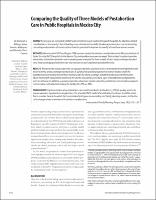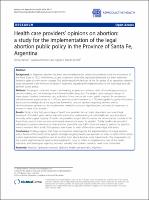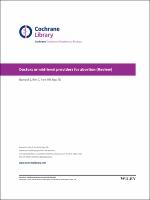Mostrar el registro sencillo del ítem
Improving care of women at risk of unsafe abortion: implementing a risk-reduction model at the Uruguayan-Brazilian border
| dc.contributor.author | Fiol, V | |
| dc.contributor.author | Briozzo, L | |
| dc.contributor.author | Labandera, A | |
| dc.contributor.author | Recchi, V | |
| dc.contributor.author | Piñeyro, M | |
| dc.date.accessioned | 2014-07-03T16:41:37Z | |
| dc.date.available | 2014-07-03T16:41:37Z | |
| dc.date.issued | 2012 | |
| dc.identifier.citation | International Journal of Gynecology & Obstetrics, 2012 (118)1, p S21-S27 | es_ES |
| dc.identifier.issn | 0020-7292 | |
| dc.identifier.uri | http://clacaidigital.info/handle/123456789/550 | |
| dc.description.abstract | OBJECTIVE: To describe the initial stages of the implementation of a risk-reduction model designed by Iniciativas Sanitarias to shield women from unsafe abortion in a traditional community on the Uruguay-Brazil border. METHODS: This mixed-design study was conducted first between 22 and 26 March 2010, and then between 2 and 7 May 2011, in Rivera, Uruguay, to gather information from women seen at health centers, healthcare providers, and local policy makers before the project started and midway through the project. RESULTS: At baseline most women and providers considered abortion justifiable only on narrow grounds, yet favored the implementation of a risk-reduction model that would include preabortion as well as postabortion counseling, the former providing information on different abortion methods and their risks. By the midterm assessment, the counseling service had assisted 87 women with unwanted pregnancies. Of the 52 who came for a postabortion visit, 50 had self-administered misoprostol, with no complications. Women were highly satisfied with the counseling. At baseline, misoprostol seemed to be available from both pharmacists and informal sellers. At midterm, it was still available from informal vendors but pharmacists said they did not provide misoprostol. The risk-reduction initiative heightened public attention to the abortion issue but the controversy it generated did not seriously impede its implementation. CONCLUSION: It is feasible to implement the proposed risk-reduction model in a traditional community such as Rivera, not only in Uruguay but in any country irrespective of its abortion laws. | es_ES |
| dc.description.uri | http://download.journals.elsevierhealth.com/pdfs/journals/0020-7292/PIIS0020729212002408.pdf | es_ES |
| dc.language.iso | en_US | es_ES |
| dc.subject | Aborto terapéutico | es_ES |
| dc.subject | Aborto seguro | es_ES |
| dc.subject | Atención postaborto | es_ES |
| dc.subject | Embarazo no deseado | es_ES |
| dc.subject | Uruguay | es_ES |
| dc.subject | Brasil | es_ES |
| dc.title | Improving care of women at risk of unsafe abortion: implementing a risk-reduction model at the Uruguayan-Brazilian border | es_ES |
| dc.type | Article | es_ES |
Ficheros en el ítem
Este ítem aparece en la(s) siguiente(s) colección(ones)
-
Artículos [158]
-
Artículos académicos [299]
-
2. América Latina y el Caribe [894]
-
Aborto autogestionado [32]
-
Uruguay [83]



